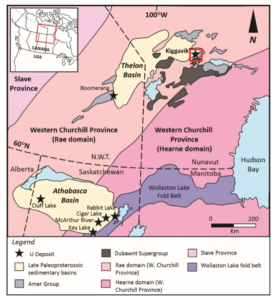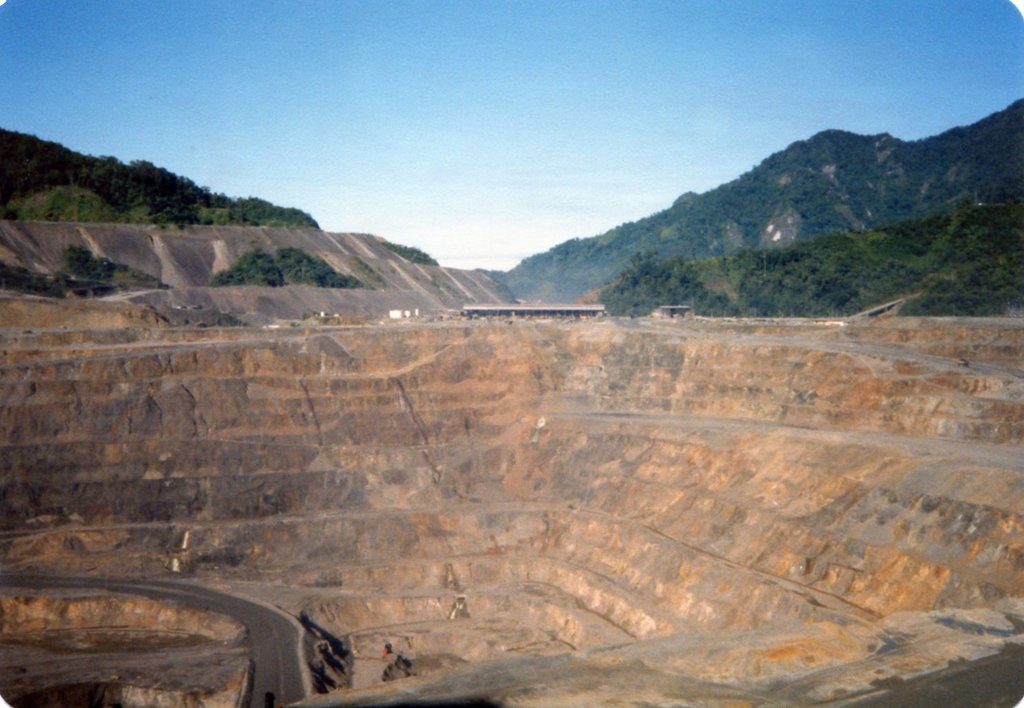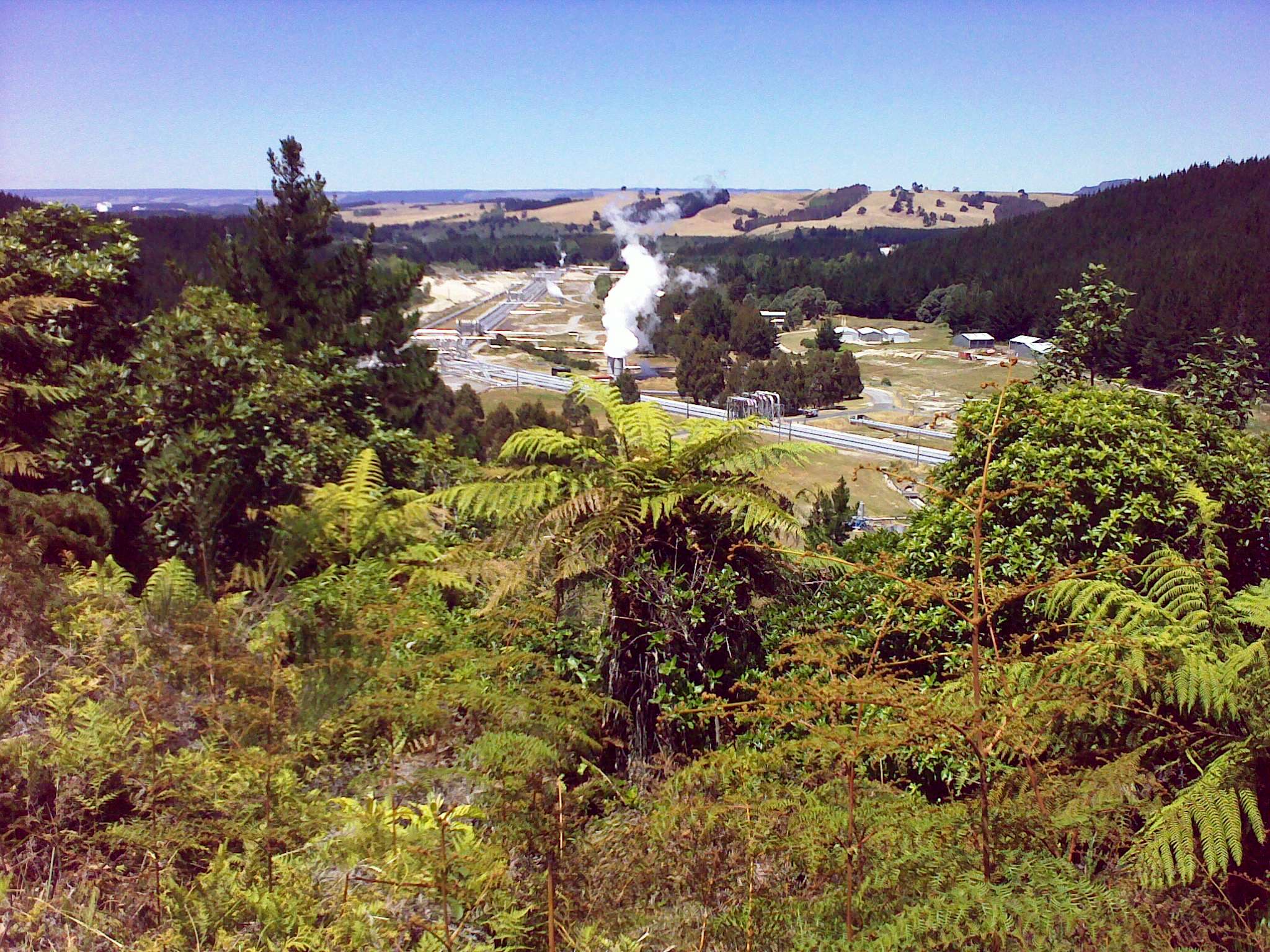When it comes to forming deposits, Uranium (U) is a uniquely versatile element. With no less than 15 deposit types recognized, it can be found in everything from pegmatites to placers to hydrothermal veins. Unconformity deposits, however, stand out from the crowd: with grades sometimes exceeding 10% U (more than 1000 times higher than many low-grade deposits), tonne for tonne these deposits host the most valuable ore on Earth.
What Is An Unconformity?

An unconformity is a boundary between two rock units that reflects a time gap. The time gap is a result of either erosion (removal of rock) or non-deposition (a time when no rocks were deposited). The rocks below the unconformity surface are older than the rocks above, and were exposed to erosion for a longer period of time.
Unconformity Deposit Formation
Most unconformity deposits formed between about 1.75 and 1.4 billion years ago, during a time known as the Proterozoic. During the Proterozoic, the low oxygen content of the atmosphere and a lack of land plants allowed U to behave very differently than it does today. Fluids circulating in large sedimentary basins would slowly dissolve U-bearing minerals, eventually becoming saturated with U. When these fluids reach the unconformity, the boundary between the sedimentary rocks of the basin and the igneous/metamorphic rocks (basement) beneath it, they encounter an abrupt change in chemistry between the oxidized basin rocks and the reduced basement rocks. This change from oxidized to reduced conditions triggers the deposition of U-oxide minerals, mainly uraninite/pichblende (UO2). Nearly all deposits are closely associated with fault systems, which play a major role in the ore-forming process by providing a conduit for fluids to cross the unconformity.

Unconformity deposits are further divided into two types: sandstone-hosted and basement-hosted. Sandstone-hosted (also known as polymetallic or egress-style) deposits are found tens-to-hundreds of meters above the unconformity in basin sandstones. They are generally thought to have formed as a result of reduced fluids coming out of the basement and mixing with oxidized basin fluids to trigger U deposition. While U is the main economic element, these deposits often contain other valuable metals such as nickel, copper, cobalt, lead, and even gold.

Basement-hosted (also called monometallic or ingress-style) deposits are found in the igneous or metamorphic rocks below the unconformity. They are thought to have formed from oxidized basin-derived fluids flowing into the basement, where large amounts of reduced minerals such as sulfides or graphite trigger reduction and U deposition. As the monometallic label implies, U usually goes it alone in this type of deposit.
Global Unconformity Deposits
Most unconformity deposits are found in just three areas: the Athabasca Basin, Saskatchewan, Canada; the Thelon Basin, Nunavut, Canada; and the McArthur River Basin, Northern Australia.
Athabasca Basin – Canada
The Athabasca Basin deposits are among the largest and richest in the world. Grades vary considerably between the dozens of known deposits and showings. Although most grades are <5% U, some reach grades of 16% or higher. Tonnage is often quite large as well, with some deposits hosting 100,000s of tonnes of U metal. Both sandstone-hosted and basement hosted deposits are found in the basin, with some deposits straddling the unconformity itself. Most known deposits occur at <500 m depth. Many large deposits are associated with graphite-rich faults, which are thought to have acted as near-ideal traps for triggering deposition of unusually large and high-grade ore zones.

Many mines have operated in the Athabasca Basin since exploration began in the 1970s, but only one, the Cigar Lake Mine, is currently in operation. This one mine accounted for 13% of world’s U production in 2019, and, as of 2017, produces the world’s most valuable ore per tonne. The McArthur River Mine produced the second most valuable ore in the world. The mine still has very large reserves, but is currently in care and maintenance mode, awaiting more favorable U prices before reopening. Cigar Lake and McArthur River are both owned by Cameco (NYSE:CCJ).
Thelon Basin – Canada

The Thelon Basin deposits are perhaps the least understood, largely due to their remote location in central Nunavut. All deposits in the area are basement-hosted, and actually occur just outside the basin, probably as a result of erosion eating away at the basins’ areal extent. Although it’s difficult to be sure, it’s widely believed that the Thelon and Athabasca basins are remnants of a single, large basin that would have covered much of northern Canada 1.5 billion years ago. In many respects these deposits seem quite similar to many Athabasca Basin deposits, although graphite is absent.
Deposits in the Thelon Basin area are not as large and high-grade as the Athabasca deposits. The Kiggavik Project (which encompasses most of the region’s known mineralization) has reserves of ~50 000 tonnes U at a grade of ~0.5%. There is no currently active exploration or mining in the area.
McArthur River – Australia
Northern Australia’s McArthur River deposits are basement-hosted and somewhat lower grade (~0.2%) than the Canadian deposits. They are also somewhat unusual in that they may contain significant amounts of gold and platinum group elements.
Uranium mining has proven to be controversial in Australia. The McArthur River deposits are in close proximity to a national park and there has been opposition from local indigenous groups. Only two U mines in the area entered production, the last of which, Ranger, ceased operations earlier this year after an impressive 40 years of production. Ranger is owned by Energy Resources of Australia (OTCMKTS:EGRAF), a subsidiary of Rio Tinto.
Exploration and Mining
 Unconformity U deposits can be detected by radiometric surveys if they are shallow enough for radiation to reach the surface. The highly characteristic alteration envelopes consisting of illite/sericite and chlorite that surround unconformity deposits are readily spotted if they reach the surface.
Unconformity U deposits can be detected by radiometric surveys if they are shallow enough for radiation to reach the surface. The highly characteristic alteration envelopes consisting of illite/sericite and chlorite that surround unconformity deposits are readily spotted if they reach the surface.
Sandstone-hosted deposits tend to be easier to explore for since they typically have larger alteration envelops and are closer to the surface. Basement-hosted deposits often present ‘blind’ targets with little or no surface expression. Uranium ore minerals may be difficult to detect with most geophysical methods, but the faults that host them are often easier to find. Many deposits in the Athabasca Basin have been discovered by drilling conductive graphite-bearing faults, which show up clearly on electro-magnetic geophysical surveys and are known to be highly prospective.
Unlike many sandstone-type U deposits (not to be confused with sandstone-hosted unconformity deposits), unconformity deposits are generally not suited to extraction by low cost in-situ leaching methods. Instead, they must be extracted by open-pit or underground mining. The radioactivity of high-grade ore poses a health risk for underground miners. Thus, companies use robotic mining techniques as much as possible. In addition to being one of the most automated mines in the world, Cigar Lake uses a unique system where ore is frozen before being cut out and liquified by high-pressure water jets. This system minimizes exposure to radiation while preventing flooding, which has been a major issue due to the porous nature of the host sandstone.
Future Outlook
There are currently over a dozen proposed mines and advanced exploration projects in the Athabasca Basin, and new high-grade deposits continue to be found. Exploration in the Athabasca Basin has focused on areas where the unconformity is shallower and deposits are easier to find and exploit, mostly around the basin’s eastern margin and Carswell impact structure. Most of the 100 000 km2 Athabasca Basin remains underexplored, and there’s a great deal of optimism in the exploration and research communities that many large deposits remain to be discovered.
The possible common origin of the Athabasca and Thelon basins, and potentially several other small basins in northern Canada, also suggests the possibility of unconformity mineralization across a large, and virtually unexplored, swathe of northern Canada. Australia’s McArthur Basin is also rather underexplored and may well host more undiscovered deposits.
With no shortage of resource, U production is not limited by supply, but by demand. Uranium demand is overwhelmingly driven by the nuclear industry, and U price often mirrors the fortunes of nuclear power. Prices rose dramatically in the late 2000s as the industry seemed poised for a ‘nuclear renaissance’, only to drop sharply following the Fukushima disaster in 2011. They have remained largely stagnant since. The increasing need for green electricity, however, may change this situation.

An unusually large number of reactors are scheduled to enter service in the next few years, and U demand is likely to continue to grow. Both the Canadian and American governments have announced large amounts of funding for developing the next generation of nuclear reactors. Billionaires are also getting involved: Bill Gates has come out as an advocate for, and major investor in, nuclear power, while Jeff Bezos’s Blue Origin space company is partnering with Lockheed Martin and the U.S. military’s DARPA in a straight-out-of-science-fiction program to build nuclear rockets.
While U demand grows, supply has dropped following several major mine closures, currently meeting less than 90% of demand. The shortfall is expected to grow over the next few years. Uranium was one of the best performing commodities in 2020, climbing nearly 50% to ~$29/lb, although it still has a way to go to reach the ~$50/lb many new projects require to enter production.
It’s too soon to say if whether all of this will translate into a boom in mining in the Athabasca or elsewhere, but it seems unlikely that such an energy-dense resource can remain underexploited for much longer in an increasingly energy-hungry world.
List of Companies Mentioned
Further Reading
- Jefferson, C. J., Thomas, D., Quirt, D.H., Mwenifumbo, C.J., and Brisbin, D. (2007): Empirical models for unconformity-associated uranium deposits. In: “Proceedings of Exploration 07: Fifth Decennial International Conference on Mineral Exploration”, edited by B. Milkereit, p. 741-769
- World Nuclear Association (2021): Uranium in Canada Retrieved from https://www.world-nuclear.org/information-library/country-profiles/countries-a-f/canada-uranium.aspx
References
- CNSC (2021): Nuclear facility – Cigar Lake Mine. Retrieved from: https://nuclearsafety.gc.ca/eng/uranium/mines-and-mills/nuclear-facilities/cigar-lake/index.cfm
- Jefferson, C. J., Thomas, D., Quirt, D.H., Mwenifumbo, C.J., and Brisbin, D. (2007): Empirical models for unconformity-associated uranium deposits. In: “Proceedings of Exploration 07: Fifth Decennial International Conference on Mineral Exploration”, edited by B. Milkereit, p. 741-769
- Shabaga, B., Fayek, M., Quirt, D., Jefferson, C., and Camacho, A. (2017): Mineralogy, geochronology, and ghttps://ourworldindata.org/safest-sources-of-energyenesis of the Andrew Lake uranium deposit, Thelon Basin, Nunavut, Canada’ Can. J. Earth Sci., 54, 850–868.
- Sharpe, R. (2013): THE GEOCHEMISTRY AND GEOCHRONOLOGY OF THE BONG URANIUM DEPOSIT, THELON BASIN, NUNAVUT, CANADA. MsC thesis, 213 pages.
- Wikipedia (2021): Uraninite, Retrieved from: https://en.wikipedia.org/wiki/Uraninite
- World Nuclear Association (2021): Uranium in Canada Retrieved from https://www.world-nuclear.org/information-library/country-profiles/countries-a-f/canada-uranium.aspx
Subscribe for Email Updates









